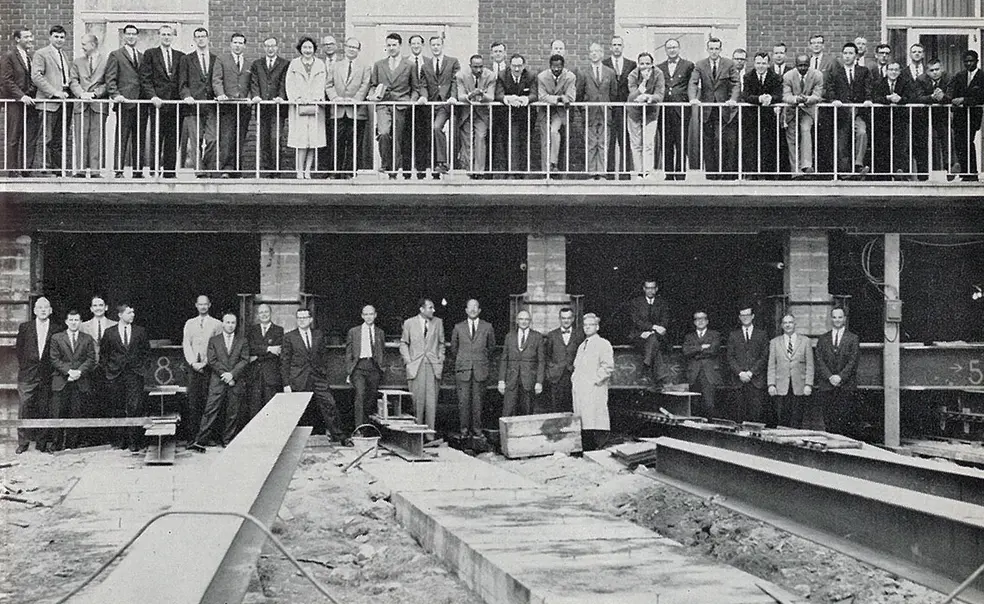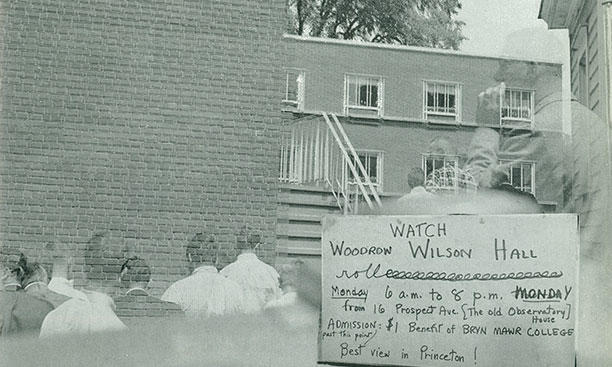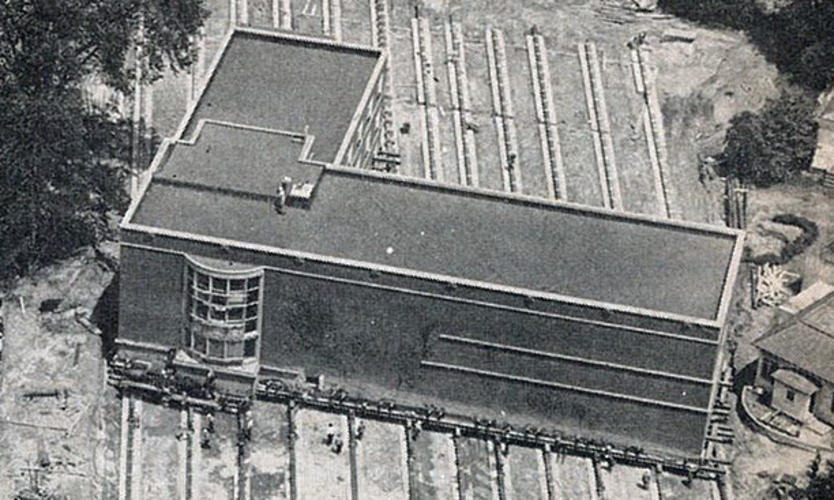How many alumni could recognize Corwin Hall, let alone pick it out by name? The unassuming red brick building, which sits next to Robertson Hall and connects to Bendheim Hall, is largely obscured by trees. But its history is unique. Built in 1951 as the home of the Woodrow Wilson School, it was soon uprooted: In 1963, it was quite literally carted off to make way for Robertson, architect Minoru Yamasaki’s distinctive modernist design.
At the time, Corwin was considered something of an eyesore, so there was little protest when the University announced its intentions to relocate the 7-million-pound building. However, people were fascinated by the project itself, which involved “38 men, nine hydraulic jacks, and one whistle.” Preparations took place throughout the spring of 1963. New foundations were constructed, and 12 steel tracks were installed ahead of time. On May 20, the building was pushed 296 feet northeast. Neighbors sold seats to the 12-hour affair, though the building’s movement was almost imperceptible.
A time-lapse video (shot by Lawrence Rauch *49, who donated the footage to the Princeton University Archives) shows the mechanics of the move, though not the three-month process of securing the building in its new foundations. When that was completed, Wilson Hall was rechristened. Its namesake: Edward S. Corwin, who had previously inherited another position originally occupied by Wilson, the McCormick Professor of Jurisprudence. Professor Robert P. George, who now holds that title, has an office in Corwin Hall.
Below, read PAW’s coverage of the move and view additional photos.
Moving Woodrow Wilson Hall
(From the June 7, 1963, issue of PAW)Sir Francis Bacon thought one of the great engineering feats of all time was Domenico Fontana’s erection of the great obelisk in front of St. Peter’s on September 10, 1586, which was accomplished by 907 men, 75 horses, 40 windlasses and one trumpet. One wonders what he would have thought if he had been in Princeton on May 20, 1963, when a 3-story, L-shaped, 7,000,000-pound building was moved 296 feet in 12 hours by 38 men, 9 hydraulic jacks and one whistle.
The process: 12 steel tracks on concrete foundations were built through the building like skewers in a Thanksgiving turkey, leading to the foundation at the new site. Then the load on the reinforced concrete columns of the building was transferred to the tracks by placing steel collars on the columns; these collars, equipped with roller bearings, rode on the tracks. The building having been cut off three feet above the basement, all was ready for the big slide. With draperies, Venetian blinds, furniture, even a defiant wisp of ivy still in situ, the great craft set off, gently but firmly nudged by 2,000-pound per square inch hydraulic jacks.The spectacle was somewhat anticlimactic: the six-inch per minute movement was imperceptible to the naked eye, although Betty Menzies by a one-minute interval double exposure (above) contrived to suggest what was happening. By the technique of hydraulic “steering” the Hall was never more than ½ inch off course and now sits snugly on its new foundation.The old Astronomy Observatory and house attached nearby on Prospect Street will be razed, and the enlarged corner site at Washington Road will then be occupied by a reflecting pool and the new 210-foot-long building for the Woodrow Wilson School designed by Minoru Yamasaki; the approximately $250,000 cost of the move, like that of the Yamasaki building, will be borne by the $35,000,000 foundation which endowed the School’s expanded graduate program. Woodrow Wilson Hall slid within inches of the Observatory and Director’s ever-alert wife, Mrs. Lyman Spitzer, sold choice seats for $1, realizing $75 for her alma mater, Bryn Mawr; like most things around the modern Princeton, Woodrow Wilson would have liked that too, since he was a professor at Bryn Mawr once himself.
















1 Response
Margaret Ruttenberg ’76
4 Years AgoI Was There!
I do not recognize myself in the photograph of the school children, but I was there. Lydia Spitzer and I were in the same third grade class at 185 Nassau Street. Her mother let us all sit with our teacher on the lawn to watch Corwin Hall move while we ate our bag lunches without charge. Doreen Canaday Spitzer was generally speaking a woman of breathtaking good cheer and generosity. Even her alma mater Bryn Mawr was second to that.